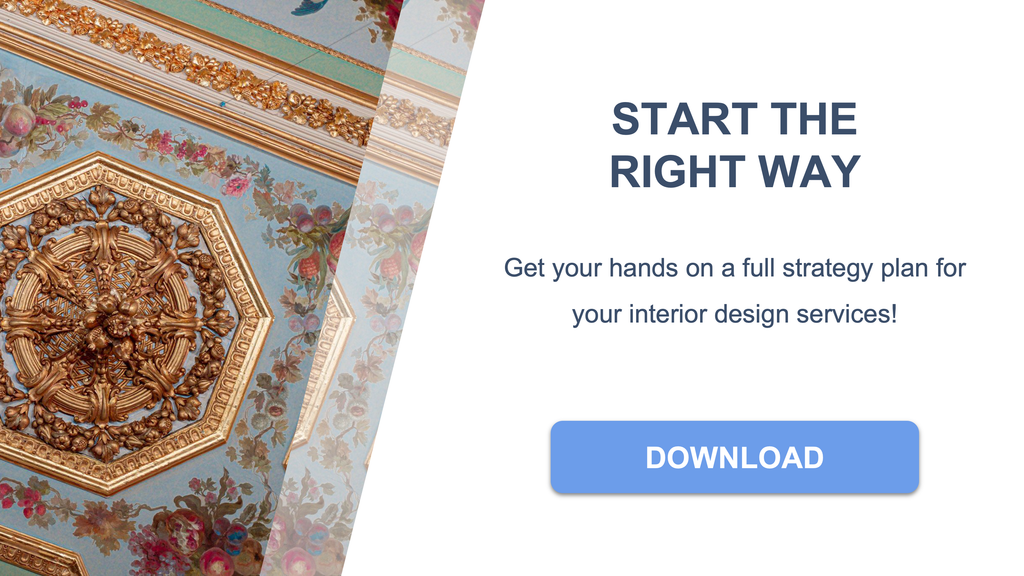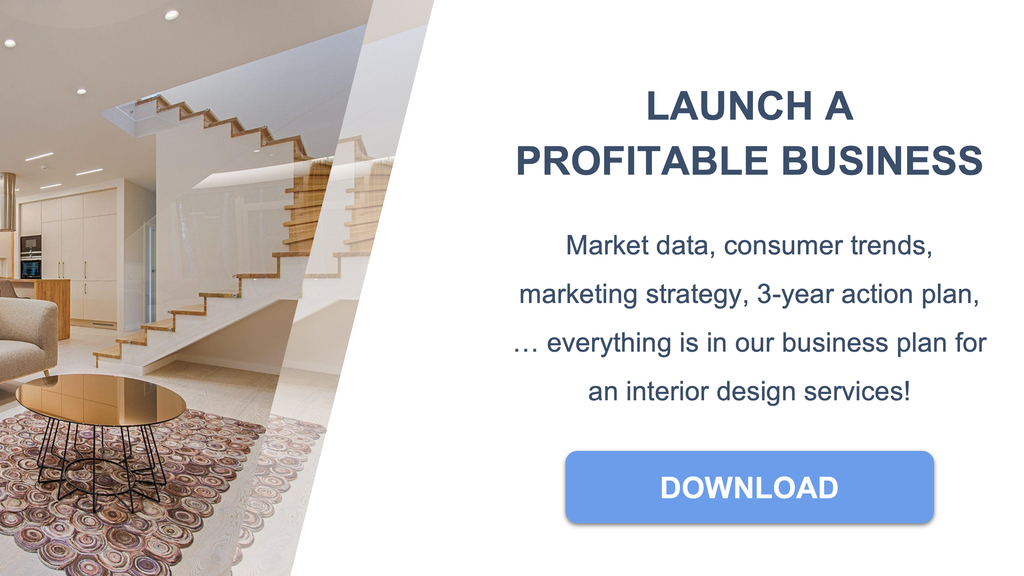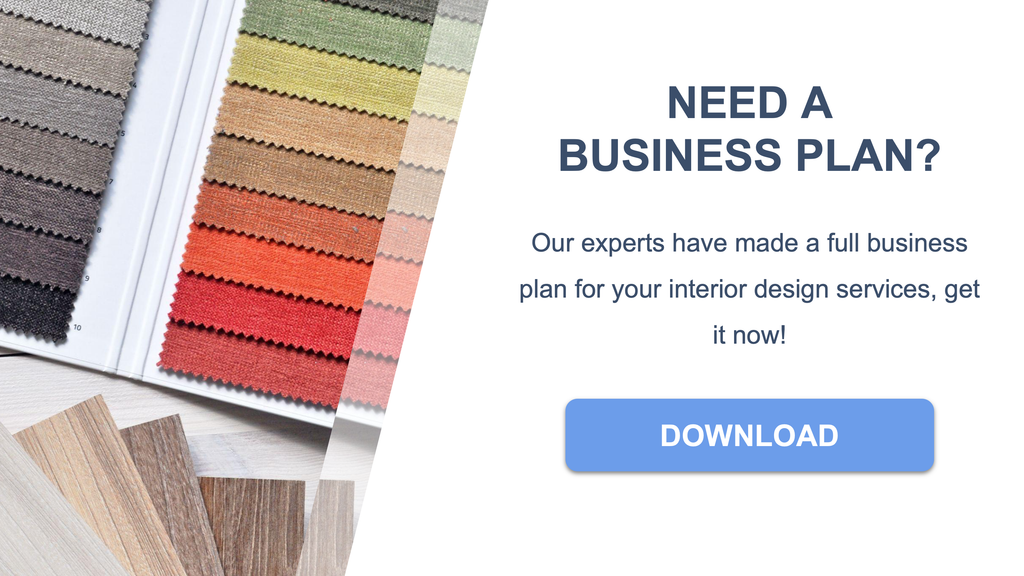This article was written by our expert who is surveying the industry and constantly updating the business plan for an interior designer.

This guide summarizes the key statistics and forecasts for the global home décor market as of October 2025, written for entrepreneurs launching or growing an interior design business.
It focuses on market size, growth outlook, regional demand, winning product categories, consumer behavior, distribution shifts, digital tools, style movements, sustainability, competitive dynamics, and macro drivers. Use it to position your interior design services, price confidently, and prioritize the right channels and offers.
If you want to dig deeper and learn more, you can download our business plan for an interior designer. Also, before launching, get all the profit, revenue, and cost breakdowns you need for complete clarity with our interior designer financial forecast.
The home décor market in 2025 is sized between USD 681–960 billion, with credible forecasts pointing to USD 1.05–1.62 trillion by 2030–2033. For an interior designer, the fastest opportunities concentrate in APAC growth cities, sustainability-led segments, and digitally enabled client journeys.
Growth depends on urbanization, housing turnover, disposable income, and e-commerce adoption; winners blend premiumization, AR-enabled visualization, and transparent eco-material sourcing into clear value propositions for clients.
| Dimension | 2025 Status / Data Points | 2026–2033 Outlook (What it means for interior designers) |
|---|---|---|
| Global market size | USD 681–960B market value (variance by source) | USD 1.05–1.62T by 2030–2033; plan service mix for rising demand in furnishings, textiles, lighting |
| CAGR | ~4.4% to 9.4% depending on scope & methodology | Base case 4.5–6.5% with upside in APAC and eco-premium niches |
| Top regions | North America ~36–43% share; APAC fastest-growing (≈8.5–11% CAGR) | Prioritize APAC expatriate hubs & NA remodeling markets; tailor pricing to local spend |
| Leading categories | Furniture 28–51% of revenue; indoor décor >60% | Premium, modular, artisanal, and sustainable lines outpace overall market |
| Channels | Specialty retail strong; e-commerce surging with AR/virtual showrooms | Hybrid studio + online visualization drives conversion and reduces returns |
| Consumer spend | US household spend ≈ USD ~2,500/yr on furnishings (recent average) | New homeowners and relocators show outsized first-year spend; design bundles win |
| Sustainability | Rising share for recycled/low-impact materials | Clear provenance and circular offers become selection criteria in proposals |

1) What is the current global market size for home décor (revenue and volume)?
The home décor market in 2025 is valued between USD 681 billion and USD 960 billion, depending on the source and scope.
This range reflects different category definitions (e.g., inclusion of furniture, textiles, lighting) and varying channels measured. Industry analysts also report differing unit volumes due to fragmented SKUs across furniture, soft goods, decorative accessories, and lighting.
As a practical benchmark for interior designers, plan capacity and supplier terms against a USD 700–900 billion core addressable market, with furniture and textiles dominating unit counts. Track local volume via retailer sell-through and renovation permits to size your city-level demand precisely.
Translate these figures into serviceable obtainable market (SOM) by mapping your project mix (full-service design vs. e-design, room refresh vs. gut remodel) to average basket sizes. Tie revenue goals to project cadence and sourcing margins.
You’ll find detailed market insights in our interior designer business plan, updated every quarter.
2) What is the projected growth over the next 5–10 years?
The market is forecast to grow at ~4.4% to 9.4% CAGR through 2030–2033.
Base-case scenarios cluster around 4.5–6.5% CAGR, with upside tied to APAC urbanization, digital adoption, and sustainability-led premiumization. Bull cases nearing ~9% CAGR assume faster housing turnover, strong disposable income growth, and low supply-chain friction.
For interior design businesses, this implies steady demand expansion and room to upsell higher-margin, eco-conscious, and modular solutions. It also supports investment in visualization, procurement systems, and post-project care plans.
Build a 3-scenario plan (base, bear, bull) for capacity and cash flow, then align staffing and vendor MOQs to the base case to protect margins.
Get expert guidance and actionable steps inside our interior designer business plan.
3) Which regions drive growth today, and which will expand the fastest?
North America holds the largest share today, while Asia–Pacific expands the fastest.
North America commands roughly 36–43% share due to mature housing stock, high incomes, and strong remodeling culture. APAC (China, India, Southeast Asia) posts the highest growth rates (~8.5–11% CAGR) on urbanization, middle-class formation, and e-commerce leapfrogging.
Europe remains sizable and innovation-led in sustainability, though near-term growth is moderated by macro uncertainty. Middle East growth tracks premium hospitality and residential development; Latin America’s growth is uneven but opportunity-rich in metros.
Interior designers should localize sourcing and logistics for APAC projects and target North American remodeling waves with premium packages.
| Region | 2025 Position | 2026–2033 Outlook & Implications for Interior Designers |
|---|---|---|
| North America | Largest share (~36–43%) | Stable growth via renovations and DIY/DIWM; emphasize project management and premium finish packages |
| Europe | Large, sustainability-forward | Regulation favors eco-materials; market clients expect certifications and circular options |
| Asia–Pacific | Fastest growth | Urban middle class expands; offer modular, space-saving, and digitally visualized design |
| Middle East | Premium new builds | Hospitality & luxury resi; prioritize high-end finishes and turnkey procurement |
| Latin America | Selective metro growth | Focus on resilient supply chains, cost transparency, and phased scopes |
| Africa | Early-stage but rising | Target commercial/hospitality hubs; partner with local artisans and importers |
| Southeast Asia | Key APAC sub-engine | Leverage social commerce and cross-border e-commerce for furnishings curation |
4) Which product categories generate the most revenue, and how will they evolve?
Furniture leads revenue (≈28–51%), with indoor décor >60% of total spend.
Textiles (rugs, curtains, linens), decorative accessories, and lighting follow as critical attachment categories with high margin potential. Premium, modular, and artisanal goods grow faster than mass-market lines.
Expect demand to shift toward space-saving, multifunctional pieces, wellness-oriented materials, and connected lighting. Bespoke and small-batch items command pricing power when origin and craftsmanship are transparent.
Interior designers should negotiate tiered discounts across furniture, textiles, and lighting, bundling them into fixed-fee or cost-plus project packages.
This is one of the strategies explained in our interior designer business plan.
5) How are consumer spending habits changing (average household expenditure)?
Households continue to allocate meaningful budgets, with the US averaging around USD ~2,500 annually on furnishings in recent years.
New homeowners and relocators spend disproportionately more in the first 12–18 months, while renters increasingly refresh with textiles, lighting, and small furniture to avoid high-move costs. Social media influence and “room-by-room” budgeting drive frequent, smaller baskets.
For interior designers, phased scopes (entry, core, upgrade) and curated add-on lists increase lifetime value. Transparent procurement fees and price-anchored mood boards help clients commit earlier.
Tie your pricing to clear deliverables (concepts, revisions, procurement, installation) and show savings from trade discounts to build trust.
We cover this exact topic in the interior designer business plan.
6) Which demographics most influence demand (age, income, lifestyle)?
Three groups anchor demand: young adults (18–34), middle-aged households, and affluent 45+ renovators.
Young adults prioritize modularity, trend-forward looks, and budget control; middle-aged households emphasize durability and customization; older buyers value ergonomic comfort and timelessness. Remote work and wellness lifestyles reinforce spending on home offices and restorative spaces.
Designers should offer tiered concept packages (starter, family, premium) and ergonomic/wellness add-ons. Use demographic-aligned channels: Instagram/TikTok for young adults, Pinterest/YouTube for family planners, and referrals/real estate partners for 45+ clients.
Income segmentation remains decisive; position premium sustainable lines to higher-income ZIP codes, while offering value-curated edits for rental-dense neighborhoods.
It’s a key part of what we outline in the interior designer business plan.
7) Which distribution channels are strongest, and how will they shift?
Specialty retailers remain strong, but e-commerce and omnichannel models are gaining share quickly.
DIY/mass merchants capture traffic with price and availability, while pure-play online leaders deploy AR and rapid delivery to reduce returns. Social commerce and DTC brands intensify competition at the mid-price tiers.
Interior designers win by integrating trade-only vendors, boutique makers, and select retail SKUs into one managed cart with installation. Client experience improves via digital boards, AR previews, and consolidated delivery windows.
Expect more hybrid showrooms (physical studios + digital visualization) and tighter last-mile logistics tying designer, vendor, and client together.
| Channel | 2025 Strength | Shift Through 2030 (Designer Takeaway) |
|---|---|---|
| Specialty Retailers | High service, curated assortments | Partner for exclusive lines and better trade terms; showcase samples in studio |
| E-commerce | Rapid growth, wide assortment | Use AR and virtual try-ons to cut revisions; standardize returns in contracts |
| Mass Merchants/DIY | Value pricing, availability | Blend value SKUs into budget scopes; pre-approve quality tiers to avoid rework |
| Direct-to-Consumer | Brand storytelling, niche quality | Leverage small-batch makers for signature looks; manage lead-times early |
| Trade-Only Vendors | Designer margins, reliability | Centralize POs and tracking; negotiate volume rebates |
| Social Commerce | High discovery via influencers | Shoppable mood boards; affiliate links offset design fees |
| Marketplaces | One-stop selection | Shortlist vetted sellers; create preferred lists per style and price tier |
8) How is digital transformation (marketplaces, social commerce, AR) shaping the future?
Digital tools now influence every stage—from discovery to decision to delivery.
Online marketplaces compress sourcing time; AR and virtual showrooms lift confidence and reduce post-install adjustments; AI personalization speeds options while respecting constraints (budget, size, lead time). Social commerce fuels trend diffusion and immediate purchase intent.
For interior designers, standardized digital mood boards, AR scale checks, and live procurement trackers shorten timelines and justify fees. Client portals that show status, ETAs, and cost deltas improve satisfaction.
Invest early in visualization workflows and vendor integrations to protect margins and reduce errors.
This is one of the many elements we break down in the interior designer business plan.
9) What major design and style trends drive purchases, and how long will they last?
Multifunctional, space-saving, wellness-centric, and nature-inspired aesthetics lead today’s demand.
Calming neutrals with textured layers, biophilic elements, and tactile textiles anchor longevity; smart/connected lighting and flexible layouts reflect remote/hybrid living. Artisanal and handcrafted finishes continue to differentiate premium spaces.
Most of these trends sustain medium term (3–5 years), with palettes and accents rotating seasonally. Designers should refresh accessories while keeping foundational investments timeless.
Package “timeless bones + seasonal accents” to protect client budgets and accelerate approvals.
Get expert guidance and actionable steps inside our interior designer business plan.
10) How do sustainability and eco-friendly materials affect purchasing and forecasts?
Sustainability materially influences selection and pricing power.
Clients increasingly request recycled, responsibly sourced, and low-VOC materials with documented provenance. Brands with circular practices (refurbish, repair, take-back) gain share, and regulations in the EU accelerate adoption globally.
Interior designers who present clear eco-options with lifecycle cost explanations close projects faster and at healthier margins. Carbon-labeled options and repairability plans reduce buyer hesitation.
Embed sustainability checklists into every specification and present two eco alternatives per key line item.
This is one of the strategies explained in our interior designer business plan.
11) Who are the leading global and regional players, and how might shares change?
Global leaders include IKEA, Home Depot, Williams-Sonoma, and Wayfair, with strong omnichannel presence.
Regional specialists and DTC brands grow via niche craftsmanship, sustainability leadership, and agile supply. Market share shifts favor companies with resilient logistics, AR-enabled selling, and reliable after-sales service.
For interior designers, preferred vendor rosters should mix scale players (availability, price tiers) with boutique makers (uniqueness, customization). Annual vendor reviews protect margins and lead times.
Negotiate exclusives or early access on lines that fit your signature style to differentiate proposals.
12) Which external factors will most impact growth (housing, income, cycles)?
Housing turnover, renovation activity, disposable income, and credit conditions are the primary growth levers.
Rising mortgage rates can defer moves but often shift spending into renovations; material inflation compresses budgets unless scoped early; labor availability affects timelines. Policy changes (tariffs, sustainability rules) alter sourcing costs and compliance work.
Interior designers should monitor local permits, builder sentiment, and lead indicators (housing starts, existing home sales) to time campaigns. Flexible scopes and price locks reduce client friction during volatility.
Maintain a rolling 90-day procurement plan and a contingency vendor list for critical SKUs.
Conclusion
This article is for informational purposes only and should not be considered financial advice. Readers are encouraged to consult with a qualified professional before making any investment decisions. We accept no liability for any actions taken based on the information provided.
Looking to launch or scale your interior design business?
Explore our step-by-step resources on costs, pricing, profitability, and planning so you can make confident decisions and present clear proposals to clients.
Sources
- Mordor Intelligence — Home Décor Market
- Grand View Research — Home Décor Market
- Persistence Market Research — Home Décor Market
- Fortune Business Insights — Home Décor Market
- Future Market Insights — Home Décor Market
- Statista — U.S. Expenditure on Household Furnishings
- NAHB — Housing & Remodeling Indicators
- CBI — HDHT Market Channels & Segments
- InsightAce Analytic — Sustainable Home Décor
-Interior Designer Startup Costs: What to Budget
-Interior Designer Business Plan: Complete Template
-How to Start an Interior Design Business (Complete Guide)
-Interior Designer Markup: How Much and Why It Works
-How Much Do Interior Designers Make?
-Interior Designer Pricing: Models and Examples
-Is an Interior Design Business Profitable?
-Is Interior Design Worth Pursuing as a Career?



